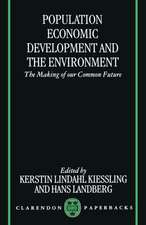Cohabitation and Marriage in the Americas: Geo-historical Legacies and New Trends
Editat de Albert Esteve, Ron J. Lesthaegheen Limba Engleză Hardback – 14 noi 2016
The book offers a tour of the historical legacies and regional heterogeneity in unmarried cohabitation, covering: Canada, the United States, Mexico, Central America, Colombia, the Andean region, Brazil, and the Southern Cone. It also explores the diverse meanings of cohabitation from a cross-national perspective and examines the theoretical implications of recent developments on family change in the Americas.
The book uses data from the Integrated Public Use Microdata Series, International (IPUMS), a project dedicated to collecting and distributing census data from around the world. This large sample size enables an empirical testing of one of the currently most powerful explanatory frameworks for changes in family formation around the world, the theory of the Second Demographic Transition.
With its unique geographical scope, this book will provide researchers with a new understanding into the spectacular rise in premarital cohabitation in the Americas, which has become one of the most salient trends in partnership formation in the region.
| Toate formatele și edițiile | Preț | Express |
|---|---|---|
| Paperback (1) | 369.01 lei 38-44 zile | |
| Springer International Publishing – 22 iun 2018 | 369.01 lei 38-44 zile | |
| Hardback (1) | 435.38 lei 3-5 săpt. | |
| Springer – 14 noi 2016 | 435.38 lei 3-5 săpt. |
Preț: 435.38 lei
Nou
Puncte Express: 653
Preț estimativ în valută:
83.32€ • 86.67$ • 68.79£
83.32€ • 86.67$ • 68.79£
Carte disponibilă
Livrare economică 25 martie-08 aprilie
Preluare comenzi: 021 569.72.76
Specificații
ISBN-13: 9783319314402
ISBN-10: 3319314408
Pagini: 330
Ilustrații: XXV, 291 p. 32 illus., 31 illus. in color.
Dimensiuni: 155 x 235 x 23 mm
Greutate: 0.75 kg
Ediția:1st ed. 2016
Editura: Springer
Colecția Springer
Locul publicării:Cham, Switzerland
ISBN-10: 3319314408
Pagini: 330
Ilustrații: XXV, 291 p. 32 illus., 31 illus. in color.
Dimensiuni: 155 x 235 x 23 mm
Greutate: 0.75 kg
Ediția:1st ed. 2016
Editura: Springer
Colecția Springer
Locul publicării:Cham, Switzerland
Cuprins
Chapter 1: A Geography of Cohabitation in the Americas, 1970-2010: Albert Esteve, Antonio López-Gay, Julián López-Colás, Iñaki Permanyer, Sheela Kennedy, Benoît Laplante, Ron Lesthaeghe, Anna Turu, Teresa Antònia Cusidó.- Chapter 2: The Rise of Cohabitation in Latin America and the Caribbean, 1970-2011: Albert Esteve, Ron Lesthaeghe, Antonio López-Gay and Joan Garcia-Román.- Chapter 3: Cohabitation and Marriage in Canada. The Geography, Law and Politics of Competing Views on Gender Equality: Benoît Laplante and Ana Laura Fostik.- Chapter 4: The Social Geography of Unmarried Cohabitation in the USA, 2007-2011: Ron Lesthaeghe, Julián López-Colás and Lisa Neidert.- Chapter 5: The Expansion of Cohabitation in Mexico, 1930-2010: The Revenge of History?: Albert Esteve, Ron Lesthaeghe, Julieta Quilodrán, Antonio López-Gay, Julián López-Colás.- Chapter 6: Consensual Unions in Central America: Historical Continuities and New Emerging Patterns: Teresa Castro-Martín and Antía Domínguez.- Chapter 7: The Boom of Cohabitation in Colombia and in the Andean Region: Social and Spatial Patterns: Albert Esteve, A. Carolina Saavedra, Julián López-Colás, Antonio López-Gay, Ron Lesthaeghe.- Chapter 8: Cohabitation in Brazil: Historical Legacy and Recent Evolution: Albert Esteve, Ron Lesthaeghe, Julián López-Colás, Antonio López-Gay and Maira Covre-Sussai.- Chapter 9: The Rise of Cohabitation in the Southern Cone: Georgina Binstock, Wanda Cabella, Viviana Salinas and Julián López-Colás.- Chapter 10: Conclusions: The Pan-American View: Ron Lesthaeghe and Albert Esteve.
Recenzii
“The authors carefully and methodically examined causes and effects over time, yielding invaluable information about the choices couples make. … Readable maps and graphs efficiently yield spatial and temporal patterns. Chapter bibliographies are rich and valuable, providing further background and insights to a better understanding of society across the Americas. Summing Up: Recommended. Upper-division undergraduates and above.” (L. Yacher, Choice, Vol. 54 (10), June, 2017)
Notă biografică
Albert Esteve Palós, demographer and researcher, is director of Centre d’Estudis Demogràfics (CED – Centre for Demographic Studies) and associate professor at the Autonomous University of Barcelona (UAB). With a degree in Geography he also has a PhD in Demography from the UAB with a thesis titled Nomenclàtor del Censo de Població i la seva aplicació a l'estudi del poblament a Catalunya (Population Census Gazetteer Files and Their Application to the Study of Settlement in Catalonia). He has been a visiting researcher at the University of Minnesota, the Institute National d’Études Démographiques in Paris and Princeton University. He has been a grant holder of the Department of Geography at the UAB for the University Teacher Training programme and of the Ramon i Cajal programme at the CED, in addition to obtaining research funding from the Spanish government’s National Plan for R&D, the Generalitat (Government) of Catalonia, and the sixth and seventh European Union Framework Programmes. In 2009 he received a Starting Grant from the European Research Council for the WorldFam project. His research is concerned with aspects related with couple formation, marriage markets and household structure, on both Spanish and worldwide scales. He has also made a significant contribution in research infrastructure projects, in particular with harmonisation and dissemination of population census microdata, in this case working closely with the Population Centre at the University of Minnesota. He has published chapters in several books and numerous articles which have been published in such magazines as Population Development Review, Demography, International Migration Review and Demographic Research.
Textul de pe ultima copertă
This open access book presents an innovative study of the rise of unmarried cohabitation in the Americas, from Canada to Argentina. Using an extensive sample of individual census data for nearly all countries on the continent, it offers a cross-national, comparative view of this recent demographic trend and its impact on the family.
The book offers a tour of the historical legacies and regional heterogeneity in unmarried cohabitation, covering: Canada, the United States, Mexico, Central America, Colombia, the Andean region, Brazil, and the Southern Cone. It also explores the diverse meanings of cohabitation from a cross-national perspective and examines the theoretical implications of recent developments on family change in the Americas.
The book uses data from the Integrated Public Use Microdata Series, International (IPUMS), a project dedicated to collecting and distributing census data from around the world. This large sample size enables an empirical testing of one of the currently most powerful explanatory frameworks for changes in family formation around the world, the theory of the Second Demographic Transition.
With its unique geographical scope, this book will provide researchers with a new understanding into the spectacular rise in premarital cohabitation in the Americas, which has become one of the most salient trends in partnership formation in the region.
Caracteristici
This open access book empirically tests one of the currently most powerful explanatory frameworks for changes in family formation around the world, the theory of the Second Demographic Transition
Presents an innovative, collaborative study of the rise of unmarried cohabitation in the Americas
Features cross-national, comparative research by using data from the Integrated Public Use Microdata Series, International (IPUMS)
Presents an innovative, collaborative study of the rise of unmarried cohabitation in the Americas
Features cross-national, comparative research by using data from the Integrated Public Use Microdata Series, International (IPUMS)

















